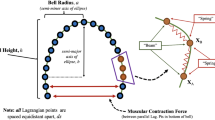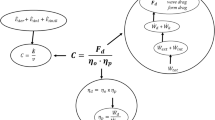Abstract
The aim of this study was to investigate how fins with varying physical characteristics affect the energy cost and the efficiency of aquatic locomotion. Experiments were performed on ten college swimmers who were asked to swim the dolphin kick while using a monofin (MF) and to swim the front crawl kick with a small-flexible fin (SF), a large-stiff fin (LS) and without fins (BF, barefoot). The energy expended to cover one unit distance (C) was highest for BF (C=10.6±1.8 kJ m−1 kg−1 at 0.8 m s−1) and decreased by about 50% with LS, 55% with SF and 60% with MF, allowing for an increase in speed (for a given metabolic power) of about 0.4 m s−1 for MF and of about 0.2 m s−1 for SF and LS (compared with BF). At any given speed, the fins for which C was lower were those with the lowest kick frequency (KF): KF=1.6±0.22 Hz at 0.8 m s−1 (for BF) and decreased by about 40% for SF, 50% for LS and 60% for MF. The decrease in KF from BF to SF–LS and MF was essentially due to the increasing surface area of the fin which, in turn, was associated with a higher Froude efficiency (ηF). ηF was calculated by computing the speed of the bending waves moving along the body in a caudal direction (as proposed for the undulating movements of slender fish): it increased from 0.62±0.01 in BF to 0.66±0.03 in SF and 0.67±0.04 in LS reaching the highest values (0.76±0.05) with MF. No single fin characteristic can predict a swimmer’s performance, rather the better fin (i.e. MF) is the one that is able to reduce most KF at any given speed and hence to produce the greatest distance per kick (d=v/KF). The latter indeed increased from 0.50±0.01 m in BF to about 0.90±0.05 m in SF and LS and reached values of 1.22±0.01 m in MF.





Similar content being viewed by others
References
Abbott AV, Brooks AN, Wilson DG (1995) Human powered watercrafts. In: Abbott AV, Wilson DG (eds) Human powered vehicles. Human Kinetics, Champaign, pp 47–92
Alexander R McN (1977) Swimming. In: Alexander R McN, Goldspink G (eds) Mechanics and energetics of animal locomotion. Chapman and Hall, London, pp 222–248
Alexander R McN (1983) Motion in fluids. In: Animal mechanics. Blackwell, Oxford, pp 183–233
Arellano R (1999) Vortices and propulsion. In: Sanders R and Listen J (eds) Applied proceedings of the XVII international symposium on biomechanics in sport. Edith Cowan University Press, Perth, pp 53–65
Cavagna GA, Kaneko M (1977) Mechanical work and efficiency in level walking and running. J Physiol (Lond) 268:467–481
Daniel TL (1991) Efficiency in aquatic locomotion: limitations from single cells to animals. In: Blake RW (ed) Efficiency and economy in animal physiology. Cambridge University Press, Cambridge, pp 83–96
Daniel TL, Jordan C, Grunbaum D (1992) Hydromechanics of swimming. In: Alexander R McN (ed) Advances in comparative and environmental physiology, mechanics of animal locomotion. Springer, Berlin Heidelberg New York, pp 17–49
Dempster WT, Gabel WC, Felts WJL (1959) The anthropometry of manual work space for the seated subject. Am J Physiol Anthrop 17:289–317
di Prampero PE, Pendergast DR, Wilson DR, Rennie DW (1974) Energetics of swimming in man. J Appl Physiol 37:1–5
Donald KW, Davidson WM (1954) Oxygen uptake of booted and fin swimming divers. J Appl Physiol 7:31–37
Gere JM, Timoshenko SP (1990) Deflections of beams. In: Mechanics of materials, IV edn. PWS Publishing Company, pp 632–633
Goff LG, Frassetto R, Specht H (1956) Oxygen requirements of underwater swimming. J Appl Physiol 9:219–221
Lauder GV, Drucker EG (2002) Forces, fishes and fluids: hydrodynamic mechanisms of aquatic locomotion. News Physiol Sci 17:235–240
Lighthill MJ (1960) Note on the swimming of slender fish. J Fluid Mech 9:304–317
Lighthill MJ (1975) Hydromechanics of aquatic animal propulsion. In: Mathematical Biofluidodynamics. Society for Industrial and Applied Mathematics, Philadelphia, pp 11–43
Minetti AE (1998) A model equation for the prediction of mechanical internal work of terrestrial locomotion. J Biomech 31:463–468
Minetti AE (2004) Passive tools for enhancing muscle-driven motion and locomotion. J Exp Biol 207:1265–1272
Minetti AE, Pinkerton J, Zamparo P (2001) From bipedalism to biciclism: evolution in bioenergetics and biomechanics of historic bicycles. Proc R Soc Lond B 268:1351–1360
Mollendorf J, Termin A, Oppenheim E, Pendergast DR (2004) Effect of swim suit design on passive drag. Med Sci Sports Exerc 36:1029–1035
Morrison JB (1973) Oxygen uptake studies of diver when fin swimming with maximum effort at depths of 6–179 feet. Aerospace Med 44:1120–1129
Pendergast DR, Tedesco M, Nawrocki DM, Fischer NM (1996) Energetics of underwater swimming with SCUBA. Med Sci Sports Exerc 28:573–580
Pendergast DR, Mollendorf J, Logue C, Samimy S (2003a) Evaluation of fins used in underwater swimming. Undersea Hyperb Med 30:57–73
Pendergast DR, Mollendorf J, Logue C, Samimy S (2003b) Underwater fin swimming in women with reference to fin selection. Undersea Hyperb Med 30:75–85
Pendergast DR, Zamparo P, di Prampero PE, Mollendorf J, Capelli C, Cerretelli P, Termin A, Craig A, Bushnell D, Paschke D (2003c) Energy balance of human locomotion in water. Eur J Appl Physiol 90:377–386
Rome LC, Swank D, Corda D (1993) How fish power swimming. Science 261:340–343
Sanders RH, Cappaert J, Devlin RK (1995) Wave characteristics of butterfly swimming. J Biomech 28:9–16
Specht H, Goff LG, Brubach HF, Bartlett RG (1957) Work efficiency and respiratory response of trained underwater swimmers using a modified self contained underwater breathing apparatus. J Appl Physiol 10:376–383
Toussaint HM, Beelen A, Rodenburg A, Sargeant AJ, De Groot G, Hollander AP, van Ingen Schenau GJ (1988) Propelling efficiency of front crawl swimming. J Appl Physiol 65:2506–2512
Ungerechts BE (1983) A comparison of the movements of the rear parts of dolphins and butterfly swimmers. In: Hollander AP, Huying PA and de Groot G (eds) Biomechanics and medicine in swimming. Human Kinetics, Champaign, pp 215–222
Ungerechts BE, Persin U, Colman V (1999) The application of vortex formation to self propulsion in water. In: Keskinen KL, Komi PV, Hollander AP (eds) Biomechanics and medicine in swimming, vol VIII. Gummerus Printing, Jyvaskyla, pp 95–100
Webb PW (1971) The swimming energetics of trout. II. Oxygen consumption and swimming efficiency. J Exp Biol 55:521–540
Wilson B, Thorp R (2003) Active drag in swimming. In Chatard JC (ed) Biomechanics and medicine in swimming, vol IX. Publications de l‘Université de Saint Etienne, pp 15–20
Woledge RC, Curtin NA, Homsher E (1985) Energetic aspects of muscle contraction. Academic, London
Zamparo P, Pendergast DR, Termin B, Minetti AM (2002) How fins affect the economy and efficiency of human swimming. J Exp Biol 205:2665–2676
Zamparo P, Pendergast DR, Mollendorf J, Termin B, Minetti AM (2005) An energy balance of front crawl. Eur J Appl Physiol 94:134–144
Acknowledgements
We acknowledge the technical assistance of Chris Eisenhardt, Dean Marky and Frank Modlich during the experiments and the patience and kind cooperation of the swimmers. Also, we would like to thank Dr. Scott White and Laura Malczewski for helping in the video data analysis and Dr. Miriam Isola for helping with the statistical analysis. This research has been partially supported by the US navy, NAVSEA, Navy Experimental Diving Unit, Contract N16 33199C0028.
Author information
Authors and Affiliations
Corresponding author
Rights and permissions
About this article
Cite this article
Zamparo, P., Pendergast, D.R., Termin, A. et al. Economy and efficiency of swimming at the surface with fins of different size and stiffness. Eur J Appl Physiol 96, 459–470 (2006). https://doi.org/10.1007/s00421-005-0075-7
Accepted:
Published:
Issue Date:
DOI: https://doi.org/10.1007/s00421-005-0075-7




